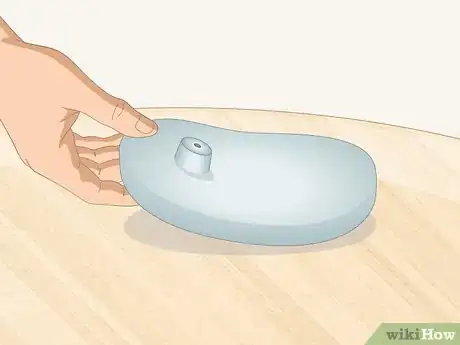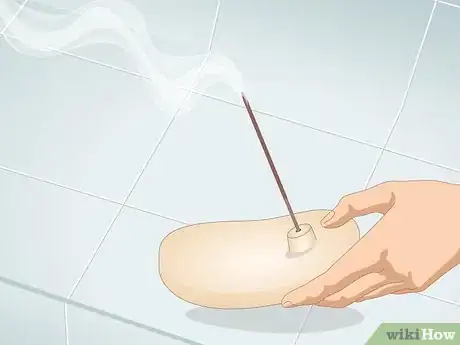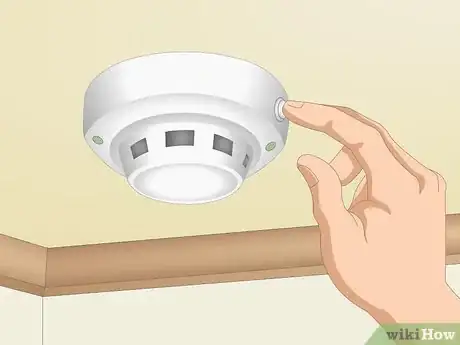This article was co-authored by wikiHow Staff. Our trained team of editors and researchers validate articles for accuracy and comprehensiveness. wikiHow's Content Management Team carefully monitors the work from our editorial staff to ensure that each article is backed by trusted research and meets our high quality standards.
This article has been viewed 8,271 times.
Learn more...
Burning incense is a popular way to create a calm and soothing atmosphere. Whether you’re burning incense for its relaxing aroma or using incense for religious or ceremonial purposes, it’s important that you make safety a priority in order to prevent an incense fire. To burn incense safely, make sure that you choose a safe holder and location for your incense while using general fire safety practices.
Steps
Lighting and Burning Incense
-
1Use a durable incense holder. When you choose a holder for your incense, select an option that is heavy and durable to reduce the risk of it breaking or falling over. While small, flat stick incense holders, as well as glass holders, are quite popular, these lightweight, delicate options tend to be flimsy and are more prone to falling over.[1]
- Metal, ceramic, and concrete holders that are large, heavy, and encase the incense are generally safer options.
-
2Keep incense away from flammable materials and liquids. When you’re setting up your incense holder, position it away from flammable fabrics, paper, plastics, alcohol, and oils to reduce the risk of igniting a fire. In addition, keep your incense away from houseplants when it’s burning, as these can also ignite if they come into contact with burning incense.[2]
- While there are no hard and fast rules or recommendations about exactly how far away you should place your incense from potentially flammable liquids and materials, use your best judgement to place the holder far enough away so that it wouldn’t ignite anything if it fell or blew over.
- Curtains, clothing, books, and newspapers, for example, are highly flammable and should be kept far away from burning incense.[3]
Advertisement -
3Place your incense holder on a non-flammable, heat-resistant surface. To reduce the risk of causing an incense fire, always place your incense holder on a non-flammable, heat resistant surface, such as concrete or brick. These surfaces can withstand the heat from the holder and won’t ignite if your incense holder happens to fall over.[4]
- Surfaces like concrete and brick are also sturdy and heavy, making it less likely that they will fall over and spill the incense on wood flooring, rug, or carpet.
-
4Extinguish burning incense in water or sand. If you’re burning incense and you plan to leave the room or go to sleep before it burns all the way down, you can extinguish both incense sticks and cones by sticking them in water or sand. This will help you avoid the risk of starting an incense fire by leaving it unattended while burning.[5]
- Incense sticks can also be extinguished by smashing the tip into an astray or on concrete.
Using General Fire Safety
-
1Stay in the room whenever you’re burning incense. Leaving burning incense unattended is the most common cause of incense fires. Therefore, it’s important that you always stay in the room so you can keep an eye on the incense and make sure it’s burning as intended.[6]
- Even if you leave for just a minute, it’s possible that the incense holder could overheat and break, causing the burning incense to fall and ignite any nearby flammable materials.
- Some incense holders also tend to be flimsy and are easily overturned by wind, air conditioning, or by the weight of the burning incense itself.
-
2Avoid burning incense in prohibited areas. If you plan to burn incense outside of your own home, always check with the building compliance and fire safety codes to make sure that burning incense isn’t prohibited. Many college campus residence halls, medical centers, and other institutions have banned the use of incense because of the heightened risk of fire.[7] Therefore, it’s important that you avoid burning incense in prohibited places and only use incense within regulations.
-
3Test your smoke detector every month to make sure it’s working. Even if you’re careful when burning incense, it’s still important to test your smoke detector in case the incense does cause a fire. To make sure that your smoke detector is working properly, press the “test” button on the top or side. For most devices, this will cause the detector to emit a loud noise that will let you know the device is working and that it will detect any smoke.[8]
- Most smoke detector manufacturers recommend that you test your device once every month.
-
4Choose an incense substitute to negate the risk of causing a fire. Because there is always a risk of igniting a fire when you burn incense, you may want to choose an alternative. While alternatives don’t hold the same religious and ceremonial value for some people, if you’re burning incense for the aroma, you may want to consider placing fresh cut herbs and flowers, an essential oil diffuser, or potpourri in your home instead.[9]
- There are also several non-combustible, non-burning incense options on the market today. While these may not have the same aroma or properties as burning incense, they are a good substitute if you’re worried about causing an incense fire.
References
- ↑ https://fireprevention.utexas.edu/firesafety/fire-safety-awareness
- ↑ https://blog.cstx.gov/2018/02/08/burning-incense-grilling-can-be-hazardous-if-misused/
- ↑ https://fireprevention.utexas.edu/firesafety/fire-safety-awareness
- ↑ https://blog.cstx.gov/2018/02/08/burning-incense-grilling-can-be-hazardous-if-misused/
- ↑ https://fireprevention.utexas.edu/firesafety/fire-safety-awareness
- ↑ https://emergency.vanderbilt.edu/vu/fire/factsheets/firefacts_smoking_candles.pdf
- ↑ https://emergency.vanderbilt.edu/vu/fire/factsheets/firefacts_smoking_candles.pdf
- ↑ https://fireprevention.utexas.edu/firesafety/fire-safety-awareness
- ↑ http://mysmokefreehousing.org/word/IncenseFactSheet.pdf

















-Step-11-Version-2.webp)

















































